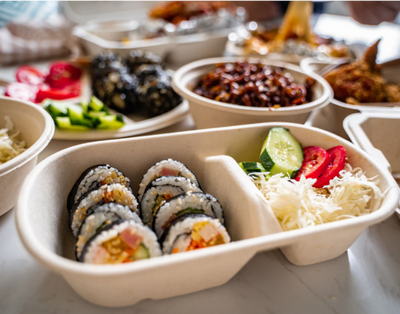The massive global reliance on food delivery and takeaway service has exposed a critical flaw in the modern food system: the massive amount of single-use, non-recyclable plastic containers, lids, and cutlery generated daily. The traditional plastic or Styrofoam clamshell is now recognized as an environmental liability, driving consumers and regulators to demand better.
For the Food and Beverage (FnB) industry, the solution isn't just "less plastic," it's a complete shift in material science. Compostable packaging has emerged as the definitive new standard for takeaway and delivery, offering the most practical, scalable, and environmentally sound alternative to traditional plastic.
This is a deep dive into why certified compostable materials are non-negotiable for modern sustainable packaging in the FnB sector.
The Failure of the Traditional Takeaway Container
For decades, FnB businesses chose plastic and foam for two reasons: cost and moisture resistance. However, their true costs—environmental and economic—are now undeniable.
-
The Recycling Illusion: Most plastic food containers are too contaminated with grease and food residue to be effectively recycled, meaning they go directly to the landfill.
-
Toxicity and Persistence: Foam and many plastics contain chemicals that can leach into food, particularly when hot. More critically, they persist for centuries, polluting land and marine ecosystems.

The Compostable Advantage: Closing the Loop
Certified compostable packaging is different because its end-of-life is designed to be beneficial. Products are made from renewable, plant-based materials (like corn starch, potato starch, or sugarcane pulp) and must meet strict testing standards (such as ASTM D6400).
-
Genuine Sustainability: When composted correctly in a commercial facility, these containers break down entirely into nutrient-rich soil, completing a circular cycle. This isn't just less waste; it's resource recovery.
-
Performance and Safety: Modern compostable materials, such as those made from sugarcane bagasse, are robust, microwave-safe, freezer-safe, and highly resistant to grease and heat. They perform as well as, or better than, plastic without the risk of chemical leaching.
-
The Hygienic Advantage of Single-Use: While reusables are the gold standard for dine-in, for takeaway and delivery, a single-use, certified solution ensures hygiene and convenience while still fulfilling the highest environmental commitment.
Why EQUO is Leading the Charge in Compostable Takeaway
For FnB businesses, switching to sustainable packaging requires a partner who can supply diverse, certified, and high-performing products. EQUO specializes in transforming agricultural byproducts into the very solutions the industry needs:
-
Sugarcane Containers and Bowls: Utilizing the fibrous residue of sugarcane, these containers are extremely sturdy, perfect for hot soups, curries, and full meals, eliminating the need for weak paper or petroleum-based foam.

-
Coffee Ground Cutlery: Offering a premium utensil that diverts a waste stream (coffee grounds). This unique product serves as a brand statement that communicates deep sustainability commitment to the customer.

-
Variety of Straws: Providing the right certified compostable straw for every type of drink—from the durable coffee straw for cold brews to the natural grass straw for sodas—demonstrates attention to detail and zero-plastic integrity.

FnB businesses that adopt certified compostable packaging are making a sound financial decision. They reduce regulatory risk, lower long-term waste management costs, and, most importantly, capture the loyalty of the rapidly growing base of eco-conscious diners who are happy to pay for ethical convenience. Compostable packaging isn't just an alternative; it is the sustainable packaging standard for the future of food service.






